Doctor Who S9E8 “The Zygon Inversion”
Contains spoilers, in duplicate
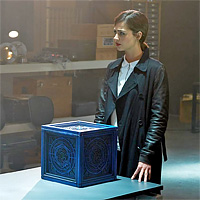 As someone who had been an out-and-proud, unabashed fan of Doctor Who’s Peter Capaldi and Jenna Coleman for sometime now, one of my biggest frustrations has been why so many other people have not been able to see the self-evident truth of their greatness as the Doctor and Clara. Initially I could kinda-sorta understand it in the latter case, since Clara’s first year was somewhat wasted being saddled with ‘the impossible girl’ label, and even once that was mercifully put to bed showrunner Steven Moffat continued to have an oddly unfocused view of the core of the character that remained. Clara ended up being pushed and pulled all over the place, first by the demands of that week’s story and then by that season’s overall arc, yet even when Clara was at her most untethered Coleman herself was always excellent, often making Clara credible purely through the force of her own will and acting talent alone.
As someone who had been an out-and-proud, unabashed fan of Doctor Who’s Peter Capaldi and Jenna Coleman for sometime now, one of my biggest frustrations has been why so many other people have not been able to see the self-evident truth of their greatness as the Doctor and Clara. Initially I could kinda-sorta understand it in the latter case, since Clara’s first year was somewhat wasted being saddled with ‘the impossible girl’ label, and even once that was mercifully put to bed showrunner Steven Moffat continued to have an oddly unfocused view of the core of the character that remained. Clara ended up being pushed and pulled all over the place, first by the demands of that week’s story and then by that season’s overall arc, yet even when Clara was at her most untethered Coleman herself was always excellent, often making Clara credible purely through the force of her own will and acting talent alone.
Similarly, I’ve completely believed in Capaldi’s Doctor ever since his opening scene in the first post-regeneration story “Into the Dalek”. I liked the whole ‘crisis of confidence’ voyage of self-discovery of season eight and how they dared to make the the Doctor a much darker and more mysterious figure than his most recent predecessors – although at the same time I’m even more thrilled by the way they’ve matured the character this season, making him warmer and more heroic while at the same time still retaining the spiky edges and the sense of alienness. And yet strangely a lot of people people seem to have remained rather cool toward the twelfth Doctor, perhaps still pining for the days of the more straightforwardly cute and adorable Matt Smith or David Tennant to return.
One theory I’ve seen is that for many, Capaldi’s Doctor has been lacking a ‘signature moment’ to match Tom Baker’s early highlight in “Genesis of the Daleks” when he debates about whether to destroy the Daleks for all time; or Sylvester McCoy’s ‘Unlimited rice pudding”; Eccleston’s “Everybody Lives!”; or Tennant showing up to a sword fight in his pyjamas and toppling a Prime Minister with a whispered “Doesn’t she look tired?”; or Smith’s full-blown rock star moment at Stonehenge. Actually I’d argue that if anything, the problem for Capaldi is that his tenure-to-date as the Doctor has been so packed full of such moments that we’ve become overloaded by them, inured and immune to their effect. Rather like the way that we develop a protective shell and become blasé about Aaron Sorkin’s genius by dismissing his work as ‘just’ a bunch of stylistic tricks and tropes, we run the risk of becoming hardened about and blind toward just what Moffat and Capaldi are achieving not just on a week-by-week basis but also in a scene-by-scene and at times even line-by-line sense.
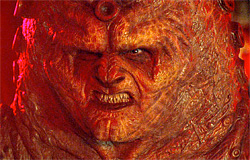 When that sort of attitude sets in it can be very hard to break through the shell and make people see the matter with fresh eyes; but from the online reaction I saw after “The Zygon Inversion” from professional critics, die hard fans and casual viewers alike then the breakthrough defining moment for the Twelfth Doctor might just have finally arrived, and it was a glorious sight to behold. The ‘truth or consequences’ third act is surely the moment that will be played on clip shows whenever they cover the Capaldi era on the show; and the only worry is that it might end up overshadowing everything else around it, because it really was that good. It’s the kind of scene where everything – concept, plot, dialogue, performance – comes together so brilliantly that if just this one scene had been in any other television series in history, that series would necessarily be instantly acclaimed an all-time classic. That it comes in a show already 52 years old and with more than 200 stories under its belt is almost unfathomable.
When that sort of attitude sets in it can be very hard to break through the shell and make people see the matter with fresh eyes; but from the online reaction I saw after “The Zygon Inversion” from professional critics, die hard fans and casual viewers alike then the breakthrough defining moment for the Twelfth Doctor might just have finally arrived, and it was a glorious sight to behold. The ‘truth or consequences’ third act is surely the moment that will be played on clip shows whenever they cover the Capaldi era on the show; and the only worry is that it might end up overshadowing everything else around it, because it really was that good. It’s the kind of scene where everything – concept, plot, dialogue, performance – comes together so brilliantly that if just this one scene had been in any other television series in history, that series would necessarily be instantly acclaimed an all-time classic. That it comes in a show already 52 years old and with more than 200 stories under its belt is almost unfathomable.
But let’s go back for a few minutes and rewind all the way to the start.
As we speculated last week, “The Zygon Inversion” picks up almost exactly where last week’s cliffhanger left off. While Moffat has been trying to buck the traditional conventions of the two-parter format, he knows that he still has to take care of business in this case and address the matter of how the Doctor and Osgood (Ingrid Oliver) escape being shot out of the sky by an anti-aircraft missile. Naturally, Moffat being Moffat, he gives us not one but two resolutions: at first it seems that the real Clara has managed to exploit the psychic link with her evil doppelgänger to cause Bonnie to inadvertently miss the plane. Hurrah! Except that you have to admire Bonnie’s perseverance, because she sticks with it and second time around the plane is duly destroyed – and given that the lead story in the headlines this weekend is still the downing of the Russian jet in the Sinai, I’m still rather surprised (in a good way) that the BBC decided to include and show that moment.
Since Doctor Who doesn’t have a $200 million blockbuster budget, what follows can only be suggested at by some nice direction by Daniel Nettheim. Actually it turns out to be a classic case of ‘less-is-more’ because with the aid of a few burning props on a beach, the simple sight gag of the Union Jack parachute implants the memory of an entire unseen scene into your brain more vividly than any amount of CGI could have managed. It’s also a sly dig at Britain’s other most successful long-running entertainment franchise, the Doctor effectively saying “Anything James Bond can do, I can do as well. Only I don’t need to show off and shout about it.”
After the cliffhanger business has been attended to, we get around to this week’s Moffat twist on the two-parter format in that after all the epic globe-trotting excitement of last week which featured planes, drones and soldiers running around shooting things, this time we get what is by comparison a small chamber piece. It consists of a series of quiet scenes with a succession of two or three characters talking to each other in anonymous rooms but with very little in the way of actual action: the power is in the words instead. It’s not a new Moffat trick – he did the same thing back at the end of season five, when the huge “The Pandorica Opens” (which saw the Doctor besieged by all his worst foes in history resulting in the irreversible death of the universe) was similarly followed by a much smaller, quieter second part in which “The Big Bang” that focussed mainly on just the four or five recurring characters running through a deserted museum trying to escape a partially-functioning Dalek; and yet it still made complete sense, both as stand-alone stories and as a coherent two-parter.
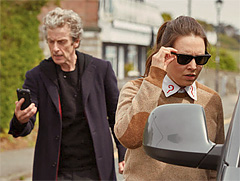 This week, the comparative quietness of “The Zygon Inversion” is signalled by the scene in which the Doctor and Osgood are regrouping by the seashore and approach a parked police car. It doesn’t take a genius to realise that these officers are acting rather oddly; and when the Doctor and Osgood try to make their exit, another police vehicle shows up and two more officers block the way out. However, it’s all very quiet and understated, taking place mainly in the out-of-focus background of the shot and all the more creepy for it. Back in the classic era of the show, Doctor Who got into trouble for daring to depict policemen as something less than completely good and wholesome and perhaps that’s why it’s careful this time around to keep everything implied rather than overt. Who knows, maybe they really were just policemen and not Zygon radicals? Either way, it’s still a strangely powerful and memorable scene even though functionally it’s nothing more than a link to get the Doctor and Osgood heading off to where they need to be.
This week, the comparative quietness of “The Zygon Inversion” is signalled by the scene in which the Doctor and Osgood are regrouping by the seashore and approach a parked police car. It doesn’t take a genius to realise that these officers are acting rather oddly; and when the Doctor and Osgood try to make their exit, another police vehicle shows up and two more officers block the way out. However, it’s all very quiet and understated, taking place mainly in the out-of-focus background of the shot and all the more creepy for it. Back in the classic era of the show, Doctor Who got into trouble for daring to depict policemen as something less than completely good and wholesome and perhaps that’s why it’s careful this time around to keep everything implied rather than overt. Who knows, maybe they really were just policemen and not Zygon radicals? Either way, it’s still a strangely powerful and memorable scene even though functionally it’s nothing more than a link to get the Doctor and Osgood heading off to where they need to be.
The next big scene (actually, a series of connected scenes) is the face-off (pardon the pun) between Bonnie and the empodded Clara. It’s an incredibly powerful confrontation, exquisitely written as the balance of power goes first one way and then another, and both sides played to utter perfection by Coleman. Again, it doesn’t surprise those of us who have long been fans of what the actress has brought to the role over the last few years, but hopefully it will be a revelation for those who needed the scales knocking from their eyes. It’s also a scene that sets the template for what’s to come, because essentially Bonnie and Clara are going through one of those role playing games you’re asked to do in management seminars about decision making, conflict resolution and general game theory. We’ll come back to that in a moment.
Meanwhile, the Doctor and Osgood have been diverted into an encounter with a random, peaceful Zygon who has been forcibly ‘outed’ by Bonnie and is now no longer able to retain his human form, pulsing through various grotesque mutations until he can’t bear it any longer. If “The Zygon Inversion” is otherwise largely a high-concept and rather cerebral episode, then this scene is where its heart lies as the poor creature pleads with them that “I’m not part of your fight. I never wanted to fight anyone – I just wanted to live here.” If you remember, last week I called the show’s willingness to tackle controversial current affairs topics “jaw-dropping” and the second part certainly doesn’t hold back on following through in this regard, the afflicted Zygon a clear representative of all those refugees fleeing civil wars and for innocents across the world caught in the middle of zealous fractions obsessed with their own wars no matter the collateral damage to innocents caught up in the middle. It’s also a direct appeal to the audience to set aside their own prejudices and to extend a helping and welcoming hand where it’s needed. No wonder the Telegraph wasn’t so keen on this week’s episode…
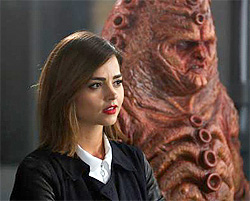 Eventually all our protagonists converge on a familiar location, UNIT’s Black Archive under the Tower of London, where the story of the Zygon invasion started two years ago in “The Day of the Doctor”. And it’s here that we fully and explicitly enter the realm of game theory, as humans (represented by Jemma Redgraves’ Kate Stewart) and Zygons (in the form of Bonnie, still wearing Clara’s form) face off in the ultimate game of Deal or No Deal. They’re each given a box in which there is a choice of two buttons: one will give them exactly what they have been after while the other will effectively or even literally destroy them. Which button is which? What will the other person do? Is it even a good idea to even dare to answer the question? Even if they manage to get everything they think they want, what does ‘victory’ ultimately really look like and can it ever be sustained or does it come with its own built-in seeds of destruction in the process? “When you’ve killed all the bad guys, and when it’s all perfect and you’ve got it exactly the way you want it, what are you going to do about the people like you?” asks the Doctor.
Eventually all our protagonists converge on a familiar location, UNIT’s Black Archive under the Tower of London, where the story of the Zygon invasion started two years ago in “The Day of the Doctor”. And it’s here that we fully and explicitly enter the realm of game theory, as humans (represented by Jemma Redgraves’ Kate Stewart) and Zygons (in the form of Bonnie, still wearing Clara’s form) face off in the ultimate game of Deal or No Deal. They’re each given a box in which there is a choice of two buttons: one will give them exactly what they have been after while the other will effectively or even literally destroy them. Which button is which? What will the other person do? Is it even a good idea to even dare to answer the question? Even if they manage to get everything they think they want, what does ‘victory’ ultimately really look like and can it ever be sustained or does it come with its own built-in seeds of destruction in the process? “When you’ve killed all the bad guys, and when it’s all perfect and you’ve got it exactly the way you want it, what are you going to do about the people like you?” asks the Doctor.
Again, it’s another one of those classic game theory thought experiments that Moffat and his co-writer this week Peter Harness have co-opted to the service of this week’s story. But what follows is ten minutes of utterly compelling television as Capaldi takes centre stage and delivers the performance of a lifetime (quite possibly, twelve lifetimes). It’s a scene that I need to go back and rewatch at least a couple of times to really get to grips with – ideally, a full transcript to pour over would be a help too – to properly appreciate how it makes its points so intelligently, effectively and entertainingly. If you’re not left for hours thinking over the issues raised in this scene then I would have to question whether you (a) have been watching and paying attention, or (b) have a brain with which to think.
Ultimately the Doctor puts it best: “This is a scale model of war. Every war ever fought, right there in front of you.” The questions addressed here apply to every conflict that there has ever been, as true now for the struggle against the forces of extremism represented by ISIL, the Middle East and Northern Ireland as to the First and Second World Wars and Korea and Vietnam all the way back to antiquity, the ever-rolling wheel of time that never stops serving up some new war to be fought and more lives to be lost. It can’t be a coincidence that the episode was scheduled to air on the same day as the UK’s annual remembrance day services, just as “Death in Heaven” did with equal relevance and emotional effect on the same weekend in 2014.
The crowning touch of brilliance to the scene is an almost throw-away line, easy to lose in the moment. This whole crisis isn’t the first time that the peace between humans and Zygons has broken down, or even the second. In fact it’s the 15th such occasion and each time the Doctor has arrived to handle the mediation and reset the peace (with the help of the memory-wipe device at the Black Archive.) The implication is that it will doubtless happen again, and again, and again, because the wheel of time keeps on rolling, humans are humans, and Zygons are Zygons. But maybe eventually by repetition things will get better and change and one day the peace will hold: because if nothing else, a fragile peace based on tolerance and forgiveness of the past actions of one’s enemies is better than more war and further bloodshed and future destruction any day of the week. In fact, in many ways it’s the only kind of peace and progress there can ever really be in the world.
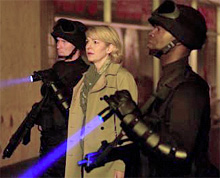 What most surprised me about the episode is the brilliance how it circles around in another rather unexpected way, becoming a narrative version of the ouroboros, the Greek symbol depicting a tail-devouring snake. The Zygon plot started as an entertaining B-story in the 50th anniversary special, a bit of light relief while the Doctor (Smith, Tennant and Sir John Hurt) were involved in ending the Time War. That had been another crisis which had boiled down to the decision of whether or not to press a big red button on a box. The reason why the Doctor makes for such a good advocate in “The Zygon Inversion” isn’t because he’s some perfect, all-knowing intelligent being far beyond our understanding, but rather because he’s stood where they are, been in their shoes, and been forced to live out the consequences of making the wrong choice. The Time Lord has never felt more real or more human or more inspiring than he has right here, right now.
What most surprised me about the episode is the brilliance how it circles around in another rather unexpected way, becoming a narrative version of the ouroboros, the Greek symbol depicting a tail-devouring snake. The Zygon plot started as an entertaining B-story in the 50th anniversary special, a bit of light relief while the Doctor (Smith, Tennant and Sir John Hurt) were involved in ending the Time War. That had been another crisis which had boiled down to the decision of whether or not to press a big red button on a box. The reason why the Doctor makes for such a good advocate in “The Zygon Inversion” isn’t because he’s some perfect, all-knowing intelligent being far beyond our understanding, but rather because he’s stood where they are, been in their shoes, and been forced to live out the consequences of making the wrong choice. The Time Lord has never felt more real or more human or more inspiring than he has right here, right now.
A lot of things that pass for entertainment these days on television, in films and books or at the theatre make for passing diversions but have no real lasting worth or merit. I might still be majorly bummed out by what happened to a popular recurring character in the third episode of the current series of The Walking Dead, and a good romcom can make me scramble to hide the fact that I’m snifling and stifling a happy tear just as much as the next man, but really in the grand scheme of things none of them actually matter outside of their own running time. But “The Zygon Inversion” is different because the issues it raises and the impact it makes really do have relevance and importance in the real world. And not just in the realm of international current affairs but in the details of our daily lives, every confrontation or sharp word we ever have with friends and loved ones and colleagues and co-workers. If you’ll pardon the cliché, this is a show that is so much bigger, more important and far more profound on the inside than you could ever guess from looking at it from the outside in the TV listings.
In the past, I’ve had my moments of being very critical about Moffat’s tenure as showrunner. I will doubtless again in the future. But from the vantage point of the middle of season nine and just a few hours after watching “The Zygon Inversion”, all I can think is that the series has surely never been as good as this before in its past and will be lucky if it ever reaches the same heights in the future. And that’s all down to Moffat; and Capaldi; and Coleman; and indeed everyone who works on Doctor Who. We’ve been lucky to have them and should appreciate them while they are here, because truly this is a golden age for the greatest science fiction series in the world.
Rating: ★ ★ ★ ★ 1/2
PS: This review is already quite long enough as it is, and even so there’s a lot left unsaid that I could have gone on to cover. But the one thing that couldn’t go unremarked upon was the impact to long-time, die hard fans of Kate Stewart’s sublime reply to the Doctor when asked how she escaped from the Zygons in New Mexico: “Five rounds, rapid.”
Doctor Who continues on BBC One on Saturday evenings.
November 9, 2015 at 5:09 pm
The Zygon Inversion has vindicated our stance on Capaldi’s divisive first season and his relationship with Coleman.